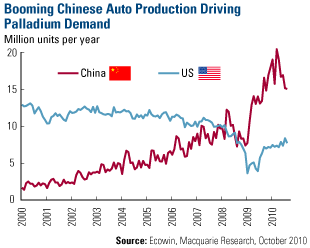LONDON—The palladium market is revving up.
After lagging behind other precious metals for much of the year,
prices for the white metal—
a key element in cars' catalytic
converters—are pulling ahead. Since the beginning of the month,
palladium has risen almost 2%, hitting a one-month high on Friday.
That's a reversal from the first quarter, when palladium fell 0.3%.
Now, investors are anticipating a squeeze—and higher prices—amid
predictions that demand will outstrip supplies in 2012 following a hefty
surplus last year.
Consumption is expected to rise because of a strong
recovery in car sales in the U.S. and China. Meanwhile, Russia has
signaled it will scale back sales of palladium from its strategic
stockpiles, which accounted for 9% of global supplies last year,
according to estimates.
Those factors already are luring speculators back to the market,
further curtailing the metal's availability to industrial users.
"It is the most attractive story" among both precious and base
metals, a category that includes copper and nickel, said Nikos Kavalis, a
commodity strategist with the Royal Bank of Scotland. While copper also
tends to rise when manufacturing activity picks up, its price is
weighed down by big inventories in China.
Palladium futures on Tuesday closed down 0.5%, to $665.15 an ounce.
RBS forecasts a surge in palladium prices to an average of $900 an ounce
in the fourth quarter and $1,000 in 2013.
Global demand for palladium will increase 4% both this year and next,
averaging 9.51 million ounces in 2013, according to estimates by BNP
Paribas.
U.S. passenger-car sales surged to 1.4 million vehicles in March, a
13% increase over the year-earlier period. In China, they rose by 4.5%
to 1.4 million. Catalytic converters are used in cars to help reduce
harmful emissions.
China is expected to tighten vehicle-emission standards later this
year. That move likely will force car manufacturers there to increase
the amount of palladium in catalytic converters, boosting the country's
need for imports, according to Barclays.
Some investors prefer palladium over platinum, a "sister" metal that
is also widely used in cars. Palladium is mostly used in gasoline
exhausts, which are more common in the U.S. and China. Platinum, on the
other hand, is for diesel-fueled cars like those driven around Europe.
Demand for new vehicles in Europe remains anemic as the Continent
struggles to fend off an economic slowdown.
That's mainly why Koen Straetmans, a strategist who manages commodity
allocations for ING Investment Management, in late March boosted
palladium exposure across the firm's 20-billion-euro multi-asset
portfolio.
"The fortunes of the respective regional car markets favor palladium," Mr. Straetmans said.
Demand is recovering at an inopportune time. Russia, which
accumulated palladium during the Soviet era, historically has dipped
into strategic stockpiles when world demand has been strong, and its
presence as a standby supplier has kept a lid on prices in the past.
But Russian officials and metals traders say those stockpiles—the
exact amount is a state secret—are dwindling. Russian officials have
repeatedly hinted in past months that stockpile sales are set to be
slashed. BNP Paribas predicts that Russia will sell 400,000 ounces of
palladium this year, 50% less than last year.
"Palladium has potentially the weakest supply outlook in 2012 of any
commodity we forecast," analysts at Barclays wrote last week. They
predicted palladium demand will exceed supply by 215,000 ounces this
year, compared with a surplus of more than 1 million ounces in 2011.
Some analysts, though, say there are technical factors in the market
that could impede palladium's rise. Even with prices up this month,
futures are below the market's 55-day moving average of $681.21 and
200-day moving average of $679.51. Moving averages indicate a
commodity's medium-term trend and can act as a cap on prices.
But investors largely are betting prices won't lose steam.
In the first quarter, they added $186 million worth of palladium
through exchange-traded products, which are mostly backed by the
physical metal, according to ETF Securities. That was the strongest
quarter in terms of net inflows since the fourth quarter of 2010.
http://online.wsj.com/article/SB10001424052702303978104577364041017374120.html?mod=googlenews_wsj

![[Most Recent Quotes from www.kitco.com]](http://www.kitconet.com/charts/metals/palladium/t24_pd_en_usoz_2.gif)
![[Most Recent Quotes from www.kitco.com]](http://www.kitconet.com/charts/metals/palladium/t24_pd_en_bpoz_2.gif)
![[Most Recent Quotes from www.kitco.com]](http://www.kitconet.com/charts/metals/palladium/t24_pd_en_yeoz_2.gif)
![[Most Recent Quotes from www.kitco.com]](http://www.kitconet.com/charts/metals/palladium/t24_pd_en_zaoz_2.gif)


